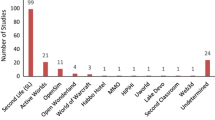Summary
Educational software on the World Wide Web can benefit from 3D content. We look at appropriate 3D technologies and give examples of existing 3D learning content on the WWW for different disciplines including pre-school education, optics, biology, and foreign languages. Finally, we discuss the future of such content and its impact on the role of the teacher.
Access this chapter
Tax calculation will be finalised at checkout
Purchases are for personal use only
Preview
Unable to display preview. Download preview PDF.
Similar content being viewed by others
References
Abadjev, V., del Rosario, M., Lebedev, A., Migdal, A., & Paskhaver, V. (1999). MetaStream. In Proceedings of VRML99 Paderborn: ACM SIGGraph.
Amon, T., & Valencic, V. (2000). VRML — enhanced learning in biology and medicine. In Future generation computing systems (in press). Amsterdam. Elsevier Publishers.
Avgoustinov, N. (2000). VRML as means of expressive 4D illustration in CAM education. In Future generation computing systems (in press). Amsterdam: Elsevier Publishers.
Boudreau, C., & Okada, M. (1998). The foreign language acquisition system of Project Orbis: An example of educational, customizable language exposure in a shared virtual world. In Future generation computing systems (in press). Amsterdam: Elsevier Publishers.
Garrett, R. H., & Grisham, C. M. (1999). Biochemistry Boston: Harcourt College Publishers. http://www.harcourtcollege.com/chem/biochem/ GarrettGrisham/GGByChapter.html
Hoppe, H. (1996). Progressive meshes. In Proceedings of SIGGRAPH96 San Francisco: ACM Siggraph.
Jung, B., & Milde, J.-T. (1999). An open virtual environment for autonomous agents using VRML and Java. In Proceedings of VRML99 Paderborn: ACM SIG-Graph.
Koenen, R. (1999). MPEG-4: Multimedia for our time. IEEE Spectrum, 36 (2), 2633.
Rourk, W. (2000). Virtual biochemistry — A case study. In Future generation computing systems (in press). Amsterdam: Elsevier Publishers.
Slater, M., Pertaub, D.-P., & Steed, A. (1999). Public speaking in virtual reality: Facing an audience of avatars. IEEE Computer Graphics and Applications, 19 (2).
Vidimce, K., Foley, J. T., Banks, D. C., Chi, Y.-T., & Mzoughi, T. (2000). WebTOP: 3D interactive optics on the Web. In Proceedings of Web3 DNRML 2000. Monterey. ACM SIGGraph.
Author information
Authors and Affiliations
Editor information
Editors and Affiliations
Rights and permissions
Copyright information
© 2002 Springer-Verlag Berlin Heidelberg
About this chapter
Cite this chapter
Diehl, S. (2002). Web-Based 3D. In: Adelsberger, H.H., Collis, B., Pawlowski, J.M. (eds) Handbook on Information Technologies for Education and Training. International Handbooks on Information Systems. Springer, Berlin, Heidelberg. https://doi.org/10.1007/978-3-662-07682-8_8
Download citation
DOI: https://doi.org/10.1007/978-3-662-07682-8_8
Publisher Name: Springer, Berlin, Heidelberg
Print ISBN: 978-3-662-07684-2
Online ISBN: 978-3-662-07682-8
eBook Packages: Springer Book Archive




